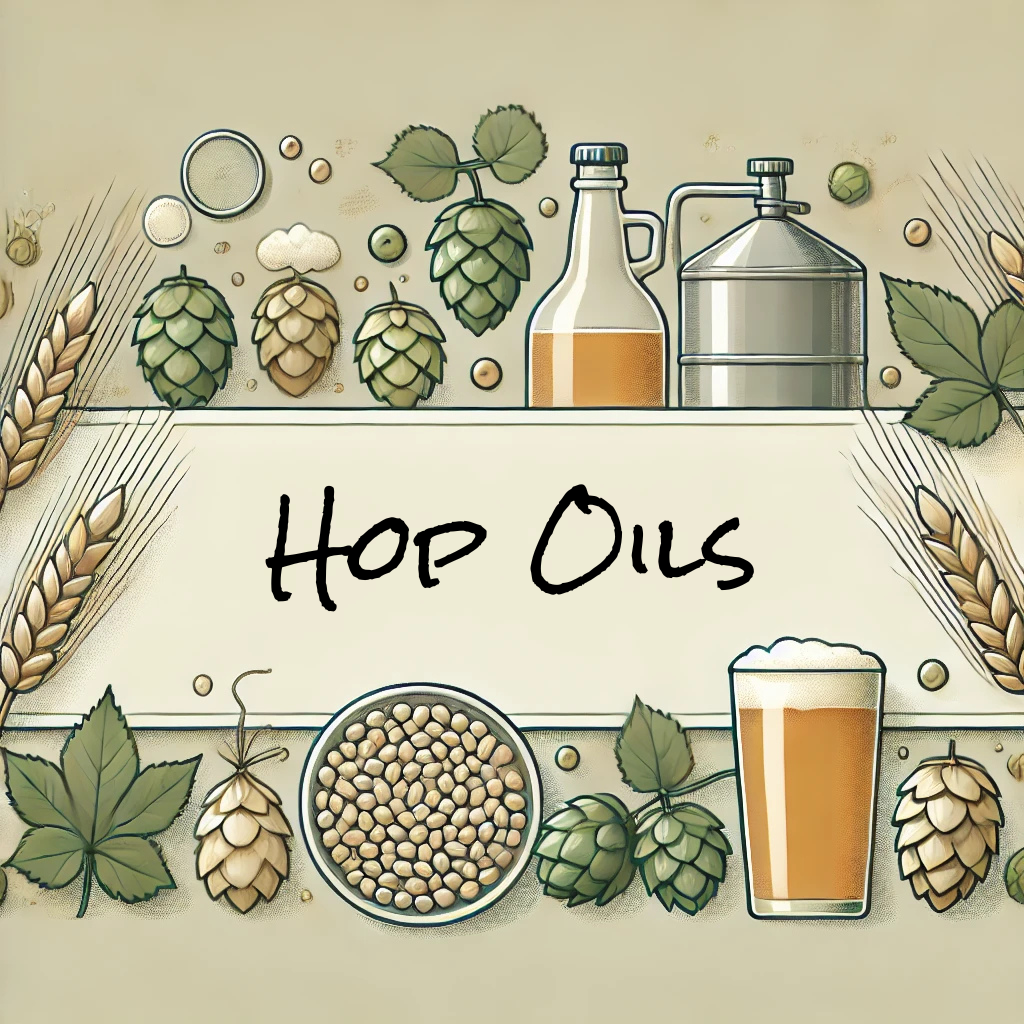
ホップオイルの世界:ビールのアロマとフレーバーを引き出す
ホップオイルの世界:ビールのアロマとフレーバーを引き出す
ホップはビール醸造の基盤であり、アロマ、フレーバー、苦味の世界をビールにもたらします。その魔法の中心にあるのが ホップオイル です。これらの複雑な化合物は、ビールの感覚的なプロファイルに大きく寄与します。パイニーなウエストコーストIPAからジューシーなNEIPAまで、ホップオイルを理解することで理想的なフレーバーとアロマを実現することができます。
ホップオイルとは?
ホップオイルはホップに含まれる揮発性化合物で、ホップコーンの重量の1~3%を占めます。これらのオイルは、多くのビールスタイルを定義するアロマのブーケの元となります。ホップオイルの正確な構成は品種や栽培条件によって異なりますが、以下の4つの主要なカテゴリーがあります。
1. ミルセン (Myrcene)
- 特徴: ハーバル、樹脂のような香り、柑橘系(マンゴーや松を連想)
- 効果: カスケードやシトラのようなアメリカンホップに多く含まれ、モダンIPAの大胆でジューシーなプロファイルを生み出します。
- 適したスタイル: IPA、ペールエール、ヘイジーIPA
2. フムレン (Humulene)
- 特徴: ウッディ、アーシー、スパイシー(黒胡椒やノーブルホップの香りに類似)
- 効果: サーツやハラタウのようなノーブルホップに多く含まれ、洗練された伝統的なホップキャラクターを与えます。
- 適したスタイル: ラガー、ピルスナー、ベルジャンエール
3. カリオフィレン (Caryophyllene)
- 特徴: スパイシー、ペッパリー、ウッディ
- 効果: フレーバーに深みと複雑さを加え、明るい柑橘系のノートとバランスを取ります。
- 適したスタイル: アンバーエール、スタウト、ポーター
4. ファルネセン (Farnesene)
- 特徴: フローラル、柑橘系、青りんご
- 効果: 微量ながら、サーツやスティリアンゴールディングのような品種で繊細なフローラルやフルーティーなノートを強調します。
- 適したスタイル: ピルスナー、ライトエール、ケルシュ
さらに掘り下げて: 専門的な化合物
- リナロール: フローラルで柑橘系、ラベンダーのような香り。ネルソンソーヴィンで顕著。
- ゲラニオール: 甘くフローラルで柑橘系、ゼラニウムを思わせる香り。
- テルピネオール: 微かな松やフローラルのトーン。
- チオール: トロピカルやパッションフルーツのアロマを生み出す硫黄化合物。ネルソンソーヴィンやモトゥエカに多く含まれる
ホップオイルの醸造への影響
これらのオイルが醸造中にどのように作用するかを理解することは重要です。
- 煮沸: 揮発性オイルはすぐに蒸発するため、煮沸中に加えるホップはアロマよりも苦味を付与します。
- ドライホッピング: 揮発性オイルを保存し、アロマとフレーバーを最大化します。
- 品種の組み合わせ: 補完的なオイルプロファイルを持つホップを組み合わせることで、その影響を強調できます。例えば、ミルセンが豊富なホップとゲラニオールが豊富なホップを組み合わせると、トロピカルなキャラクターが際立ちます。
醸造家へのヒント
- ホップを知る: 各品種のオイル構成を調べ、望むフレーバープロファイルに合ったホップを選びましょう。
- タイミングを調整する: ホップを加えるタイミング(煮沸、ワールプール、ドライホップ)を調整してオイルの表現をコントロールしましょう。
- 創造的にブレンドする: 異なるオイルプロファイルを持つホップを使用して、バランスの取れた多次元的なビールを作りましょう。
まとめ
ホップオイルは、ビールの感覚的な体験を形作る縁の下の力持ちです。これらの化合物とその作用を理解することで、醸造家は創造性とコントロールの新しいレベルを開拓することができます。ホップオイルの世界に飛び込み、大胆なフレーバーと魅力的なアロマを持つ次のビールを作りましょう。
Exploring Hop Oils: Unlocking the Aroma and Flavor of Hops
Hops are the cornerstone of brewing, imparting a world of aroma, flavor, and bitterness to beer. Central to their magic are hop oils , complex compounds that contribute significantly to a beer's sensory profile. Whether you're crafting a piney West Coast IPA or a juicy NEIPA, understanding hop oils can help you achieve your desired flavor and aroma.
What Are Hop Oils?
Hop oils are volatile compounds present in hops, making up 1-3% of the hop cone's weight. These oils are responsible for the aromatic bouquet that defines many beer styles. While the exact composition of hop oils varies by hop variety and growing conditions, there are four main oil categories to explore:
1. Myrcene
- Characteristics: Herbal, resinous, citrusy (think mango or pine).
- Contribution: Dominant in American hops like Cascade and Citra, myrcene creates the bold, juicy profiles typical of modern IPAs.
- Beer Styles: IPAs, Pale Ales, Hazy IPAs.
2. Humulene
- Characteristics: Woody, earthy, spicy (similar to black pepper or noble hop aromas).
- Contribution: Found in higher concentrations in noble hops like Saaz and Hallertau, humulene lends a refined, traditional hop character.
- Beer Styles: Lagers, Pilsners, Belgian Ales.
3. Caryophyllene
- Characteristics: Spicy, peppery, woody.
- Contribution: Adds depth and complexity to hop profiles, balancing the brighter, citrusy notes.
- Beer Styles: Amber Ales, Stouts, Porters.
4. Farnesene
- Characteristics: Floral, citrusy, green apple.
- Contribution: Rare and often found in trace amounts, farnesene enhances delicate floral and fruity notes. It’s prominent in varieties like Saaz and Styrian Golding.
- Beer Styles: Pilsners, Light Ales, Kölsch.
Beyond the Basics: Specialized Compounds
- Linalool: Floral and citrusy, often described as lavender-like. Key to hops like Nelson Sauvin.
- Geraniol: Offers a sweet, floral, and citrus character, resembling geraniums.
- Terpineol: Subtle piney and floral tones.
- Thiols: Sulfur compounds responsible for tropical and passion fruit aromas in hops like Nelson Sauvin and Motueka.
Hop Oils in Brewing
Understanding how these oils behave during brewing is crucial:
- Boiling: Volatile oils evaporate quickly, which is why hops added during the boil impart more bitterness than aroma.
- Dry Hopping: Preserves volatile oils, maximizing aroma and flavor.
- Variety Pairing: Combining hops with complementary oil profiles can amplify their impact. For example, pairing myrcene-rich hops with geraniol-heavy hops creates a robust tropical character.
Tips for Brewers
- Know Your Hops: Research the oil composition of each variety to choose hops that align with your desired flavor profile.
- Experiment with Timing: Adjust when hops are added (boil, whirlpool, or dry hop) to control the expression of oils.
- Blend Creatively: Use hops with different oil profiles to create balanced, multidimensional beers.
The Bottom Line
Hop oils are the unsung heroes of brewing, shaping the sensory experience of beer. By understanding these compounds and how they behave, brewers can unlock new levels of creativity and control in their craft. Dive into the world of hop oils, and let your next brew tell a story of bold flavors and captivating aromas.
